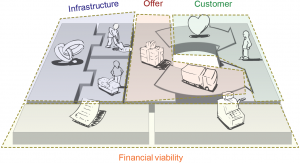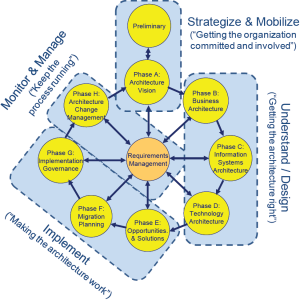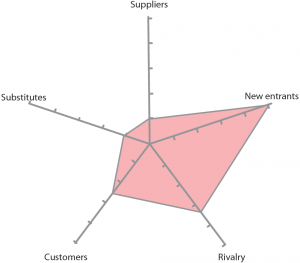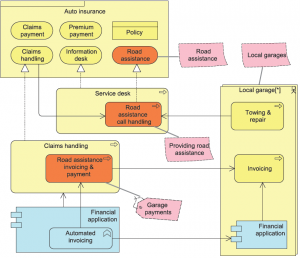





Prologue EA is a topic that is highly in debate and there are many frameworks like TOGAF, Zachman that help in defining the enterprise. This article takes reference of TOGAF for the discussion. While practicing TOGAF, it’s always implied that TOGAF is a suggestive approach and NOT a prescriptive approach. Xoriant has recently forayed into TOGAF with the help of newly formed TOGAF Certified Architects and is committed to provide solutions to the clients on the proven success stories. Background Many a times, while interacting with business houses, requirements always start with a single line or sometimes, even a clause, e.g., - We need ERP. This is where a business canvas is provisioned and plans are made to evaluate the opportunity and provide information on that. Considering entire lifecycle of a business opportunity, it’s very important to put the right starting step so that Service Provider does not incur losses. This can be best illustrated through details below. Business Canvas On a very broad level, a Business Canvas looks as below:  The various parts of Canvas are: Customer Segments - Targeted end users segmented on needs and attributes. Value Proposition - Set of products and services that distinguish from competitors. Channels - Business Vehicle to deliver value proposition, e.g., Store Fronts, SCM solutions. Customer Relationships - Different levels of interactions with customers such as Personal Assistance, Self Service etc. Revenue Streams - Means of incurring revenue such as Sale, Usage fee, Subscription fee, Licensing etc. Key Resources - Various types of assets creating value for the customer. Typically classified as Human, Financial, Physical or Intellectual. Key Activities - Most important activities in achieving business proposition. Key Partners - Strategic Business Alliances, JVs that help in optimizing operations and reducing risks of business model. Core Structure - Most important costs inherent in Business model. Typically associated with Key Resources, Key Partners, Key activities classified into fixes and variable costs. TOGAF as ADM (Architecture Development Method) TOGAF targets any enterprise problem to reach the suggestive solution. TOGAF model can be symbolized as below:
The various parts of Canvas are: Customer Segments - Targeted end users segmented on needs and attributes. Value Proposition - Set of products and services that distinguish from competitors. Channels - Business Vehicle to deliver value proposition, e.g., Store Fronts, SCM solutions. Customer Relationships - Different levels of interactions with customers such as Personal Assistance, Self Service etc. Revenue Streams - Means of incurring revenue such as Sale, Usage fee, Subscription fee, Licensing etc. Key Resources - Various types of assets creating value for the customer. Typically classified as Human, Financial, Physical or Intellectual. Key Activities - Most important activities in achieving business proposition. Key Partners - Strategic Business Alliances, JVs that help in optimizing operations and reducing risks of business model. Core Structure - Most important costs inherent in Business model. Typically associated with Key Resources, Key Partners, Key activities classified into fixes and variable costs. TOGAF as ADM (Architecture Development Method) TOGAF targets any enterprise problem to reach the suggestive solution. TOGAF model can be symbolized as below:  Hypothetical Use Case: Merging Insurance Solutions AllCovered Insurance Corporation has three distinct Insurance Domains:
Hypothetical Use Case: Merging Insurance Solutions AllCovered Insurance Corporation has three distinct Insurance Domains:
- Home Insurance – Retail and Corporate Customers
- Car Insurance – Retail Customers
- Legal Expense Insurance – Corporate Customers
Core Management decided to have merger of all 3 domains and provide a unified solution so that customer experience becomes seamless. The new name is assumed as InsBrella (Insurance + Umbrella). The below points explain how TOGAF can be mapped to such Use Case. At each phase, all the generated artifacts were stored in a common repository. Business Canvas
| Heading | Description |
| Customer Segments | Retail Customers Corporate Customers |
| Value Proposition | Unified, single platform user experience Scheduled reminders for payments Cross-sell products information based on past history and CIBIL score Discounts and sharing NCB benefits across different types of policies Benefits on bringing new customers |
| Channels | Emails Phone Calls Newsletters Social Marketing over FaceBook, Twitter Retail outlets of Mahindra Service Centers |
| Customer Relationships | Call Center SMS Web Interface for complaint resolutions |
| Revenue Streams | Sale and cross-sale Renewal of insurance Cheap offers on switching from competitor |
| Key Resources | Financial Records CIBIL Scores Customer Interaction and payments history Call Center Executives Strategic Service Partners |
| Key Activities | Development and deployment of system Integration with Mahindra Service Center solution Integration with other strategic partners |
| Key Partners | Mahindra Service Centers MailChimp Twilio Azure |
| Core Structure | InsBrella Team Board of architects governed by EA Implementation Team Strategic alliance management team Call Center |
Preliminary Phase Management focusses primarily on 3 things:
- Quality
- Priority
- Passion
Commonalities
- Similar business models
- Similar approaches of customer acquisition and marketing
- Loyal customer base
Strategize and Mobilize A team of EA analyzed the commonalities of the proposed solution and targeted for:
- Reduction in costs
- Compete in low cost market
- Seamless User Experience
EA Team gathered all information via Interviews, Group Discussions, Fixed Questions, Scenario Questions. To help in suggesting the best solution, SWOT and five forces analysis was conducted. A sample view of five force analysis looks like:  Phase A (Architecture Vision) Based on the details available from Preliminary Phase and business strategies, following strategic options were identified:
Phase A (Architecture Vision) Based on the details available from Preliminary Phase and business strategies, following strategic options were identified:
- Introduction of Value Added Services to differentiate from competitors
- Introduction of Insurance packages for cross selling
- Target new customer segments
- Invest in IT to become agile
- Reducing customer defaulters and claim payment issues
An enhanced view of one of the offerings (Auto Insurance) is as follows (where Orange color indicates new services introduction).  Business House decided to have a strategic partnership with original component vendors and Mahindra Service Centers to have reduced costs, optimized inventories and assured businesses. Phase B to Phase D (Business Architecture, Information Systems Architecture and Technology Architecture) EA Team at InsBrella ran through multiple iterations for optimizing the platform. The end result of this being a design of Agile and scalable solution using Polyglot database. At this point, all the ideas were technology agnostic and none of the platforms / technologies was selected. Phase E to Phase G (Opportunities and Solutions, Migration Planning, Implementation Governance) Various COTS solutions were evaluated to align implementation with Architecture. At the end, following is the list of some of the components selected:
Business House decided to have a strategic partnership with original component vendors and Mahindra Service Centers to have reduced costs, optimized inventories and assured businesses. Phase B to Phase D (Business Architecture, Information Systems Architecture and Technology Architecture) EA Team at InsBrella ran through multiple iterations for optimizing the platform. The end result of this being a design of Agile and scalable solution using Polyglot database. At this point, all the ideas were technology agnostic and none of the platforms / technologies was selected. Phase E to Phase G (Opportunities and Solutions, Migration Planning, Implementation Governance) Various COTS solutions were evaluated to align implementation with Architecture. At the end, following is the list of some of the components selected:
- .NET – Application level Services
- Azure Services – To host platform and build solution in agile, resilient manner
- Zapier – To connect various platforms
- MailChimp – Marketing purpose
- Twilio – SMS Gateway
While selection, great attention was given for ease of development and maintenance along with strategic partnerships and subscriptions with 3rd party services to reduce cost and bring more agility. Multiple rounds of discussion were organized so as to cover:
- Application Security
- Data Security
- Information Security
- Identity Management
- Application Resiliency
In order to migrate information to InsBrella, discussions were conducted for:
- Identifying common customers and merging data
- Protecting existing history of customers
- Unified customer records under single identity
- Integration with CIBIL services to gain insights on CIBIL score and offer cross-sells / prevent customer risks
Once an Architecture has been defined, EA team typically handles all implementation through PMO who are typically PMP / SCRUM Certified Professionals capable of handling entire implementation lifecycle. Phase H (Architecture Change Management) This was handled at each iteration. It’s typically a retrospection and introspection activity to identify the issues and handle them well in the next set of execution. Epilogue For a successful execution, based on the details mentioned above, it’s prominent that lot of things ride on the correct architecture and selection of technologies. In the referenced scenario, to achieve the final goal, following applications can be used: Creating user stories and workflows: Microsoft Visio Maintaining central Documents Repository with Metamodel: Troux Project Lifecycle Management: Team Foundation Server Application Development: Microsoft .NET Stack hosted on IIS Web Server and Windows Server Xoriant has team of very mature Architects capable of handling virtually any vertical via systematic approach. The right mix of persons with proven track of success across various solutions and clients ensure that the proposed solutions are cost effective, have better ROIs and reduced long term maintenance cost with optimum agility.
Explore Related Offerings
Related Content




Get Started

 View Previous Blog
View Previous Blog






